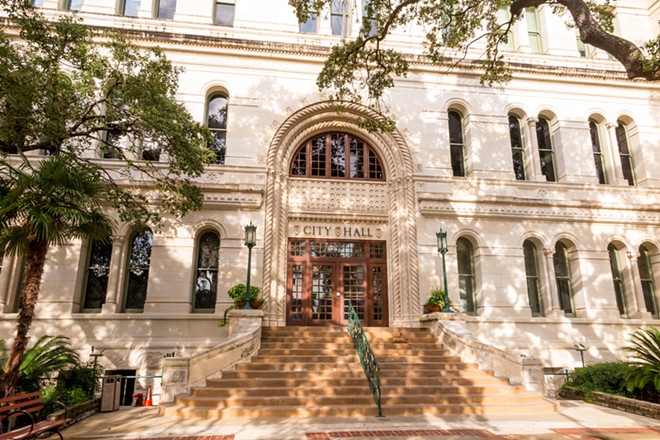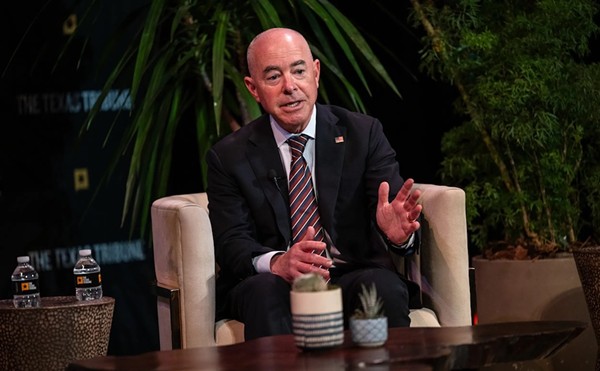
The only recording of the event available online is through a frustrating Facebook interface, and as of this writing, the footage still hasn't been uploaded to the COSAGOV's YouTube channel yet. There were never more than seven viewers watching live, and I estimate fewer than 50 people were in attendance.
Although the video has since garnered more than 600 views, that still seems low for a meeting of importance to the 1.5 million residents of San Antonio regarding a city budget that's fast approaching $4 billion.
News coverage has been slim to nonexistent. The San Antonio Report and KSAT stories focused almost exclusively on the CPS Energy presentation given by Ben Gorzell, the city's chief financial officer. Why rate hikes for customers have accompanied record profits for our municipally owned utility is surely a mystery worth pondering, but that discussion took up less than two hours of a five-hour gathering.
I could find nothing in the Express-News' coverage, for example, about Deputy Chief Financial Officer Troy Elliott's presentation on property taxes — even though the deadline to file a protest on the appraised value of one's home is May 15. Nothing either about the millions left unspent in the $891 million American Rescue Plan and State and Local Fiscal Recovery funds that the feds gave us to help shoulder the burden of the pandemic.
And most importantly, nothing whatsoever about the city's efforts to involve the wider public in the budget process — the topic of the Director of Communications and Engagement Alanna Reed's slideshow. Have you heard anything about the SASpeakUp survey anywhere?
The ETC Institute has administered community questionnaires in hundreds of cities and counties across the U.S. over the past five years, and 2023's was the first statistically valid survey conducted in San Antonio to gauge how well residents feel city services are meeting their needs and what budget items they want prioritized.
Under the auspices of SASpeakUp, another survey will begin May 9 and end May 30 with results published in June. Perhaps some media blitz is forthcoming, but given the city's abysmally meager voter turnout, journalists ought to bang this chance for civic engagement like a cheap drum.
What's painfully obvious to the point of cliche is that even at the granular level of local government, leaders don't begin with the needs of residents in mind and then work backward on how best to address
them. Instead, they start with what vested interests including large private employers and homeowner associations dictate to be possible. Then they wait for unmet needs to get so out of hand that some group of constituents squeals like a pig under a gate.
Much of this appears baked into San Antonio's governmental structure. Despite what you may think, we're not an autonomous collective. We operate on a city manager-council model, which, believe it or
not, was a reform instituted during the Progressive Era to sideline the power of political bosses and cronyism. City Manager Erik Walsh is effectively San Antonio's CEO, appointed to provide ostensibly
apolitical expertise, while the mayor, although tasked with presiding over meeting agendas, has one vote on the city council like any other elected member.
Running a city like a business has its downsides. Take the CPS Energy controversy. There's no unanimity on the council as to whether we're being ripped off. Council members expressed frustration at CPS's rate increases and lack of transparency and revenue-sharing assurances, but two members who have announced mayoral runs — District 9's John Courage and District 8's Manny Pelaez — as well as
outgoing Mayor Ron Nirenberg claim we're getting a pretty good deal.
"CPS still maintains the most affordable rates in Texas," argued Nirenberg, who also sits on the CPS Energy Board of Trustees.
That tracks. Having electricity generation that's not in the hands of a for-profit corporation answering to shareholders is a blessing worth being grateful for. Indeed, Walsh's team claims to regularly check CPS's figures, hash out any disagreements internally and report back to the council.
But that raises the question: if we own this utility, why is double-checking the numbers necessary in the first place? Shouldn't transparency be the default for the city-owned utility.
"We can give them all the money and they're still going to say, 'We need more,'" District 2 Councilman Jalen McKee-Rodriguez said of the utility.
It's difficult to argue with cynicism borne of experience. For all we know, those with their noses in the city budget are doing the best they can.
High among residents' concerns, for example, are the thousands of people walking San Antonio's streets without roofs over their heads. But I didn't hear any city leaders recommend setting a goal of functional-zero homelessness by certain date, even though other cities have accomplished exactly that. Indeed, very seldom do our council members mention what works elsewhere in the country, much less internationally.
"If we were to go and pick up every homeless person off the street today, and we'd say, 'We want to help you, come with us,' we have no place to put them," Courage, one of the two mayoral candidates said when discussing affordable workforce housing.
Yet we plan to spend nearly $3 million this year to clear out homeless encampments. Also, despite the dramatically falling murder rates last year, we plowed ahead with plans to hire 60 more police officers. It's doubtful those new cops will undergo extensive training in going after negligent landlords or white-collar fraud.
"Simply put, San Antonians don't feel safe," mayoral candidate Pelaez lamented in perilous tones, suggesting that convenience stores are "becoming more and more dangerous."
This fear-of-crime rhetoric is irresistible for politicians, data be damned, and Pelaez in particular has the
unfortunate habit of channelling 1980s-era Joe Biden. You know, back when the mass incarceration craze was in full swing and Democrats tried to outflank Republicans by preening themselves as being tougher on sentencing.
Of course, if you've ever been a victim of violent crime, not repeating the trauma is liable to top your list of priorities. But "only 2% of people are ever affected by violent crime," according to Scientific American.
"The older you are, the more likely you are to fear crime even though you're half as likely to ever experience it compared with other age groups," the magazine explained in an article titled, "Why We
Believe the Myth of High Crime Rates." Furthermore, "spending on police for neighborhoods with relatively low crime rates can divert expenditures from needier areas."
Older folks vote, however, while the young have better things to do.
Despite Nirenberg's promise to make an "equity lens" the aspirational hallmark of his legacy, Christine Drennan of Trinity University's urban studies program delivered sad news 10 months ago to Opportunity Home, formerly known as the San Antonio Housing Authority.
"When I look at life expectancy in my city, if I live in the inner city, my life expectancy is 70 years old. If I live out towards the edge of the county, my life expectancy is 88. That's a whole generation," she said.
"That's somebody gets to see their grandchildren grow up, some people don't even get to see their grandchildren. This all has to do with housing policy."
After four years and millions spent, the Ready To Work initiative has landed quality jobs for 569 participants. But, proposing the absurd, if we turned the city government into an employer of last resort and paid $25 an hour to anyone willing to pick up litter on the roadsides, I imagine the corporations we courted with our low wages would just as soon skip town.
"I used to think that if there was reincarnation, I'd want to come back as the president or the pope or as a .400 baseball hitter. But now I would like to come back as the bond market. You can intimidate everybody," James Carville, President Bill Clinton's political mastermind, once opined.
City of San Antonio CFO Gorzell dutifully reported that the city has kept its triple-A bond rating from Moody's and Standard & Poor's as well as a double-A+ from Fitch Group. That's biblical law to Chamber of Commerce-types — whereas pressing complaints, like the swarms of stray dogs biting residents, appear to get lost in the shuffle.
The Open Source software community has a saying: "Given enough eyeballs, all bugs are shallow."
That means, with enough users reviewing a program's code, eventually any mistakes will be found and
corrected. But, quite plainly, not enough everyday people from every quarter of our city are sufficiently engaged with local politics, and neither the press nor corporate-obsequious politicians seem motivated
to remedy the status quo.
Subscribe to SA Current newsletters.
Follow us: Apple News | Google News | NewsBreak | Reddit | Instagram | Facebook | Twitter| Or sign up for our RSS Feed
















